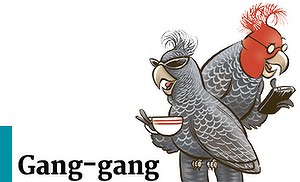 Juvenile male Gang-Gang cockatoos. Photo: Andrew GarrettThe Gang-gang cockatoo (Callocephalon fimbriatum) is famous here in the nation's capital. It is our city's faunal emblem and it gives delight to the host of Canberrans in whose gardens and neighbourhoods it manifests its endearing self. It even lends its name to a long-established and world-respected newspaper column. It is almost our bird-blessed city's best-known bird.
Juvenile male Gang-Gang cockatoos. Photo: Andrew GarrettThe Gang-gang cockatoo (Callocephalon fimbriatum) is famous here in the nation's capital. It is our city's faunal emblem and it gives delight to the host of Canberrans in whose gardens and neighbourhoods it manifests its endearing self. It even lends its name to a long-established and world-respected newspaper column. It is almost our bird-blessed city's best-known bird.
But wait! Let's not get too cocky about what we think we know of this cockatoo. It emerges that it is a fowl of mystery. There is so much to find out about it that the Canberra Ornithologists Group is marking its 50th anniversary by conducting a year-long Gang-gang survey to which all are asked to contribute.
But what is it, we quizzed Chris Davey of COG with the forensic scepticism we journalists bring to our craft, we don't know about the species?
Davey advises that what we don't know about them is ''almost everything, really''. For example, we don't even know if they breed (mate and nest and hatch their eggs) here in urban Canberra where we see and appreciate them.
We may think of them as full-time creature-citizens of our built city, and certainly we see their impossibly cute youngsters in our back gardens and parks. But there's no proof, yet, that they ever nest here. It may well be that they nest (always in holes in old trees) in tree-rich places near Canberra (in Namadgi, say) and then bring their youngsters down into our food-rich city. When and if Canberra folk contribute to this year's survey, their observations of Gang-gangs engaging in nest-making activities here in suburbs (perhaps taking nest-lining materials to holes in trees) it will be the first time any such observations will have been made and collated. There are oodles of ''what if?'' questions to be asked about the species and one relates to the lovely picture by Andrew Garrett (and, blushing, we apologise to him for on one occasion using the picture and attributing it to someone else). Now, because each of these three youngsters has some redness about its head and because adult males of the species are famously crimson-headed, we assumed (and captioned the picture accordingly) that here we have three young males. But wait! There is a suspicion (no more than that at this stage, for we simply don't have the observations, the data) that all infants of the species may have some redness about their heads at first (the females going on to rise above this foppish ostentation). And when you think about it, as Davey and other COG members mused when we met with them on Thursday, one wonders how it could possibly be that if three young Gang-gangs congregate together on a branch (as in our wondrous picture) all three will be boys? The chances of that seem very slight.
 We also haven't the foggiest idea how many Gang-gang cockatoos there are in and about the city. Because in Canberra they're so often seen and heard (that unmistakeable noise, like a coffin-lid creaking open in a melodramatic horror movie) we may fancy that there is a superabundance of them.
We also haven't the foggiest idea how many Gang-gang cockatoos there are in and about the city. Because in Canberra they're so often seen and heard (that unmistakeable noise, like a coffin-lid creaking open in a melodramatic horror movie) we may fancy that there is a superabundance of them.
But Davey tells the cautionary story of how a survey of the apparently teeming population of the currawongs of Lord Howe Island found that there were far fewer currawongs than had been imagined. Rather, it was that the currawongs were very mobile, being seen everywhere by everyone. What if Canberra has relatively few Gang-gangs but those we do have are always going hither and thither on what one might call (rather wittily in this ornithological context) their peregrinations?
AT the COG website http://canberrabirds.org.au you will find everything you need to know about how you can help with the Gang-gang survey. There is a form there for you to download to use to report what you discover.